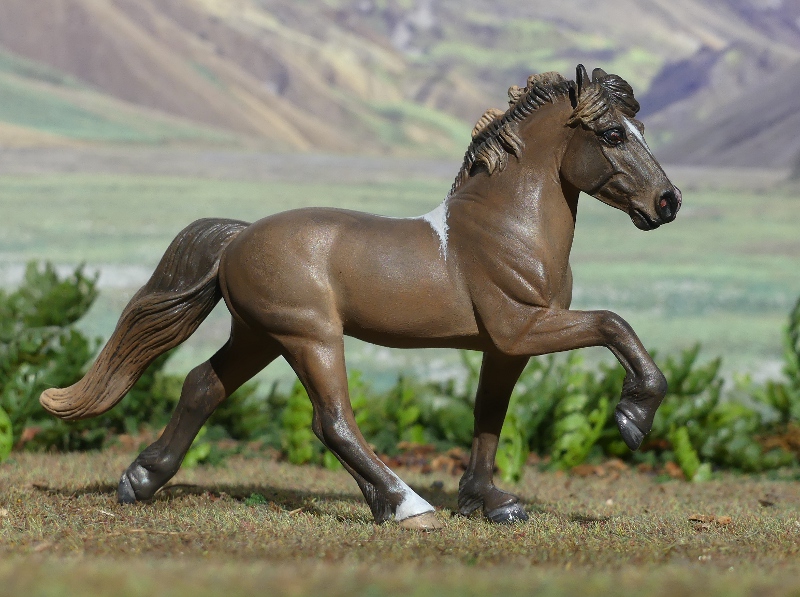I happily welcomed into my collection the Trad scale Svali frá Tjörn (who I thought was a bay, but in asking google how to type his name with the right little accents on the letters, I've discovered he's really a dark buckskin!), and later Elska the pale dappled grey on the same mould.
But the arrival of an SM-scale counterpart opens up another opportunity - not only are the releases going to be cheaper to collect, but they're also cheap enough and small enough to buy a few spare bodies and paint up some customs!
First, here's my small OF conga - Eirikke the grey 2018 regular run single, Hrimfaxi the flaxen chestnut from the 2015 mystery foal set, and Heimdallr from 2018's glow-in-the-dark set.
Last month at Burghley, I picked up a couple of duplicates of the plain grey for my body box, but they didn't spent long languishing in it, and both have already been given their new coats of paint!
The palomino was inspired by a pony in one of those free advertising-stuff horsey magazines you find in tack and feed shops. I always pick one up even though I don't really buy much for my real horses (they live out, their rugs are all second hand, and I don't buy riding gear because I don't ride!), so the advertising may not work on me but they're always handy as potential painting references for horse colours. This one provided a lovely dusty greyish shade of palomino I hadn't ever tried before, so out came the paints and here's the result!
Copying the photo also meant the shading didn't go in my usual pattern - I tend toward having the belly paler, especially behind the elbows, with the shoulder and neck darker, where this one's almost the opposite with the deepest golden tones on the girth area but much paler shading to the shoulder and neck. I think that's why it's so good to work from a photo now and then, rather than falling into a basic template of 'this is how I paint a horse' - trying to match a picture forces you out of the habits you've slipped into.
I gave him different socks and face markings than the reference, just because it's not a famous horse but someone's pet pony; it'd be a bit weird to make portraits of ones which aren't in the public eye or our own personal friends!
I've named him Falhófnir, meaning a horse with white feet - Icelandics are very often named by a physical trait, with names having literal meanings like 'brown head', 'stripe on face', or 'long mane'.
For my second Icelandic, I decided to go for one of the more obscure colours that are found in this breed, this little stallion is a smoky black. The smoky gene is a dilution factor, acting on base colours, a bit like the better known cream or dun. Actually, I was a bit concerned he was looking more like a dun during painting, but there's no dorsal stripe or leg barring, and the mane and tail fade out to brown and blond toward the tips, so hopefully he doesn't look overly grulla-like.
He did look good plain, but even as I was buying the bodies I'd wanted one to be a pinto, so I decided to go for a minimal flash of white and a small star, snip and single sock.
I've called him Gullinbursti (the name of a mythical boar ridden by Freyr in the Norse sagas), which is just a fantastic-sounding word to an English-speaking ear!
My main thought on completing them : I wish I had some more of these! I've already had a look but the single one seems to be out of stock everywhere, so I have to wait before I can paint up any more colours, but I'll definitely be adding to this conga at some point.









No comments:
Post a Comment